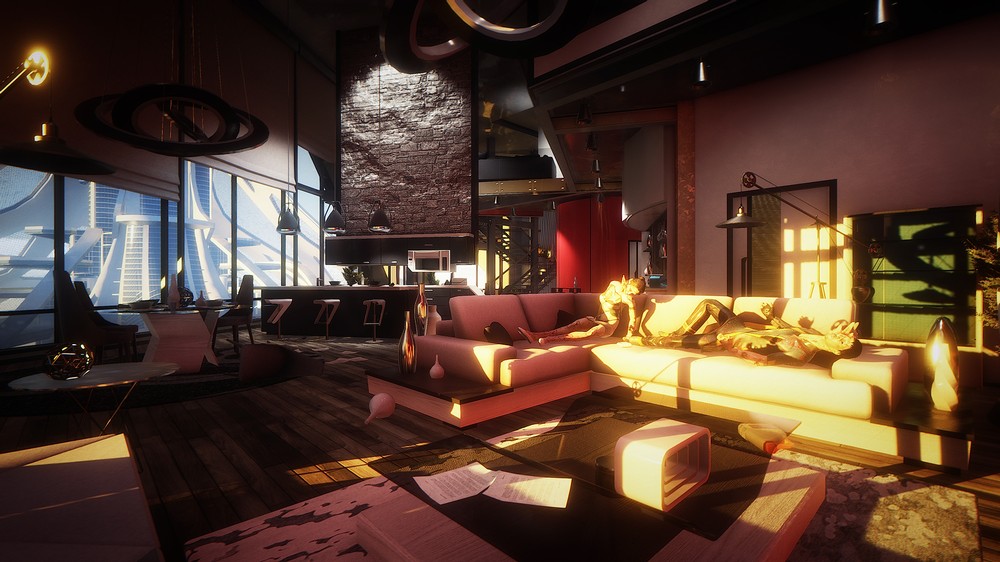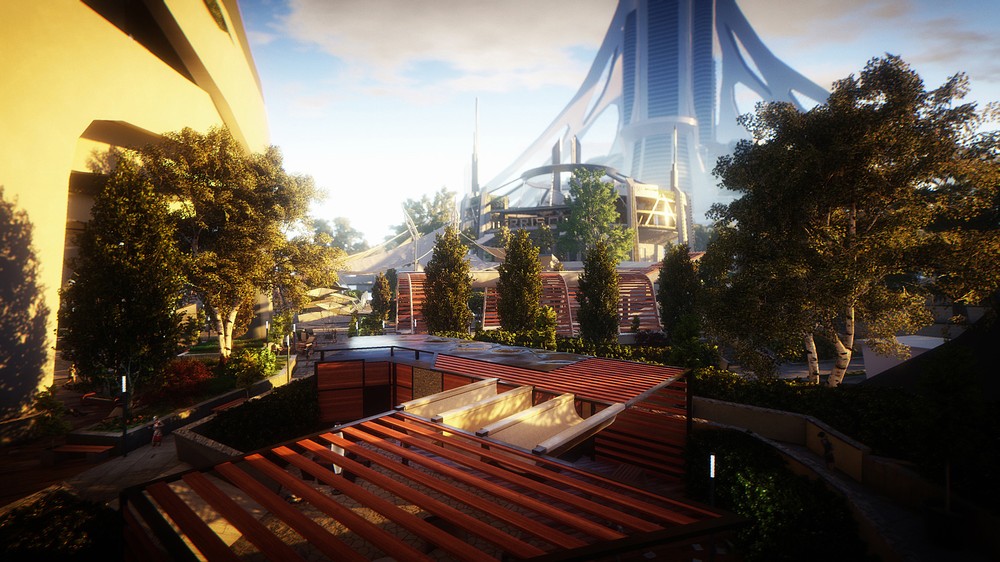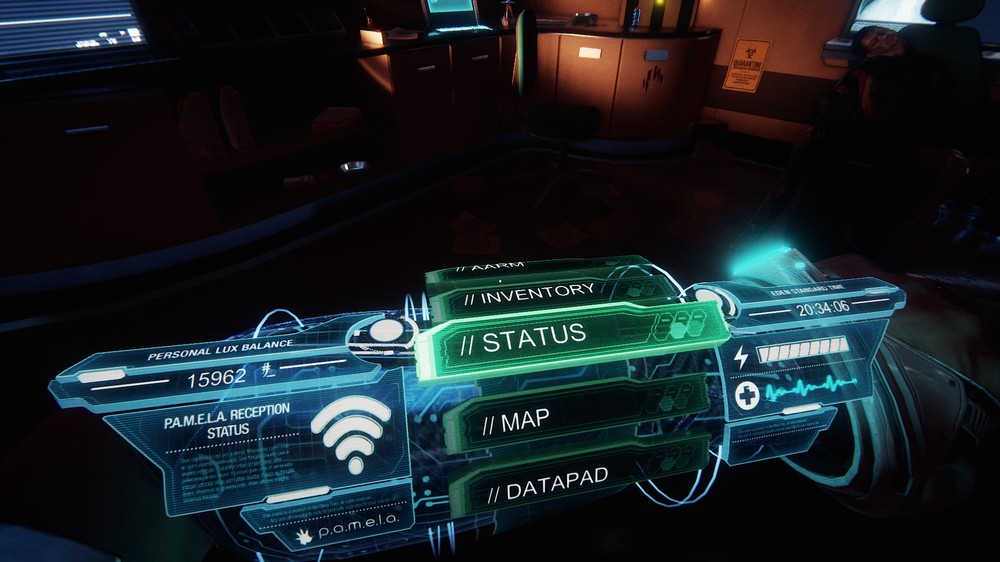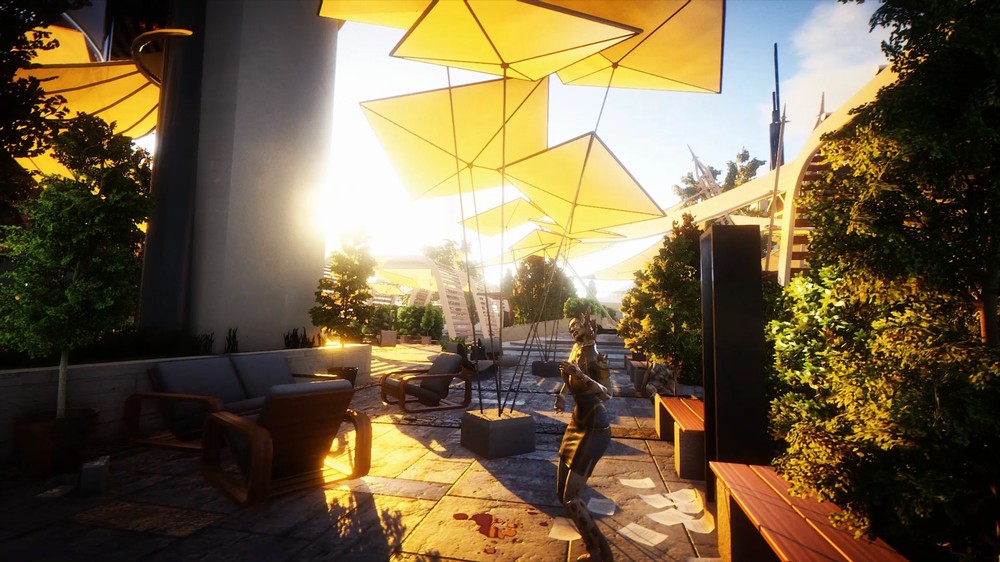In February of 2017, P.A.M.E.L.A. released as an Early Access Alpha game on Steam. At the time, when I wrote the early access review, I summarized that the game had promise of being a somewhat unique take on the otherwise ubiquitous genre of survival simulator. While many of the games in that genre were placing the character in the untamed wild of nature, or even on the surface of some harsh alien world, P.A.M.E.L.A. was the only one that I’d seen that was using the backdrop of a utopian science fiction city as the location for its survival challenge.
At the time of the early access release, the game was far from finished. There were features that had not been implemented and only hints at a lore or story. Now, over three years later, the game has come to a point where the developers have released it to a 1.0 status, which now includes a full story mode and a much more complex and well-developed set of interconnected systems. The question is, how well does it all come together?
 I feel like the game has come quite a ways from where it initially started, but I don’t know if it feels quite refined enough to be considered complete. There are some stability issues that cause framerates to fluctuate, especially in sections of the city that are more open and densely populated. The pathing of the NPC characters is awkward, often getting them stuck in corners or behind furniture. Scaling is sometimes off, as many of the NPC’s feel like they tower over the view-height of the player or door panels that are placed uncomfortably high on the walls, for example. Perhaps your character is just short?
I feel like the game has come quite a ways from where it initially started, but I don’t know if it feels quite refined enough to be considered complete. There are some stability issues that cause framerates to fluctuate, especially in sections of the city that are more open and densely populated. The pathing of the NPC characters is awkward, often getting them stuck in corners or behind furniture. Scaling is sometimes off, as many of the NPC’s feel like they tower over the view-height of the player or door panels that are placed uncomfortably high on the walls, for example. Perhaps your character is just short?
I also found that combat is still very clunky. For example, the aggressive NPC’s will often attack with lunging animations that will cause them to clip through or past you, forcing you to swing wildly back and forth as you try and track your enemy in melee combat. These issues, combined with the fact that combat is extremely lethal, is the source of many frustrating and untimely deaths. Even when you get more acquainted with the unique combat mechanics of the game, it is often frustrating and awkward.
Luckily, though the game can be played on a perma-death mode, the default option is that there is a progression that carries over from one life to the next, so that death does not necessarily mean that you have lost your progress. You can also run back to where you died and retrieve your hard-earned belongings, so death is something more of a severe inconvenience rather than a game-ending event.
 I really appreciate that while the game does make you pay attention to your character’s thirst and hunger, it also has many other goals that drive you forward. It is especially easy in survival simulators to get to a point where you feel like you’ve “beaten” the game, because you have all the tools you need to survive indefinitely. There’s no real reason to do anything else at that point other than just to wander. But, in P.A.M.E.L.A., not only are you trying to survive and to build up a somewhat protected base where you can be safe from the hordes of infected that roam the halls of the city, you are also on a mission to fix the city by restoring it to its former glory, as well as figure out exactly what the heck happened to it in the first place.
I really appreciate that while the game does make you pay attention to your character’s thirst and hunger, it also has many other goals that drive you forward. It is especially easy in survival simulators to get to a point where you feel like you’ve “beaten” the game, because you have all the tools you need to survive indefinitely. There’s no real reason to do anything else at that point other than just to wander. But, in P.A.M.E.L.A., not only are you trying to survive and to build up a somewhat protected base where you can be safe from the hordes of infected that roam the halls of the city, you are also on a mission to fix the city by restoring it to its former glory, as well as figure out exactly what the heck happened to it in the first place.
The level of complexity as far as how you can progress in this game is also quite impressive. There are many, many different things that you can craft, build, improve, augment, etc. The game also offers you the ability to augment yourself, as your character is a kind of post- or cyber-human who is able to attach various technological enhancements onto themselves in order to make survival that much easier. Everything from the light that you use to illuminate the environment during the night time hours, to the weapon that you strap to your arm are all able to be modified, improved, and altered.
The game gives you the freedom to approach the problem of restoring the city to power in many ways, and there are several different NPC types that might help or hinder you in your progress, depending on the actions that you take along the way. But now, with the newly released story campaign, there is a bit more of a guided path through the city, which will ultimately give you a more full understanding of the history of the city and what exactly happened to make it go so terribly wrong.
 The city of Eden itself is quite large; deceptively so, in fact, since it is almost entirely indoors. Made up mostly of two main buildings, the footprint of the map isn’t very massive. Especially when you consider the fact that you start in the smaller of the two towers of Eden, Arcadia, with the second tower, Olympia, being a part of the world that is, as yet, unable to be entered. But when you consider the verticality of each area and how much combined square-footage there is, especially since it is so densely packed with rooms to explore that are filled with lootable boxes, furniture, and other interesting environmental items, the scale of it is still quite large.
The city of Eden itself is quite large; deceptively so, in fact, since it is almost entirely indoors. Made up mostly of two main buildings, the footprint of the map isn’t very massive. Especially when you consider the fact that you start in the smaller of the two towers of Eden, Arcadia, with the second tower, Olympia, being a part of the world that is, as yet, unable to be entered. But when you consider the verticality of each area and how much combined square-footage there is, especially since it is so densely packed with rooms to explore that are filled with lootable boxes, furniture, and other interesting environmental items, the scale of it is still quite large.
With how massive the city is, I was surprised at the amount of space that seems to have been blocked out with the implied intention of eventually being populated and used as part of the game world, but remains inaccessible. The upper levels of the Arcadia tower, as well as the entire second, and larger tower, Olympia, are completely inaccessible, as well as lower floors of Arcadia tower that seem to exist, but are impossible to gain access to. It seems like a poor level design choice in my opinion, to have areas of a map that they took the time to create and make seem so appealing and alluring, but then block them off to the player. Perhaps there are still plans to eventually “finish” the city of Eden and map it out in its entirety. Or, perhaps the Unity engine just couldn’t handle the magnitude and scale of such a map and the designers had to stop at a certain point.
I think that this game is definitely a unique entry into the genre and one that will always stand out to me as something different from the countless others that were bland and boring. However, I think that it could still use a little more spit and polish to be considered a truly great game. Unfortunately, it remains to be seen how much more work will be put into the game or if the developers will be moving on to the next project and leaving Eden in the past.
Original Early Access Review Published March 21, 2017
The genre of Early Access Survival Simulator has become somewhat ubiquitous in the last few years. Even narrowing the field to “science fiction” games within that genre has several notable contenders. So, when I saw P.A.M.E.L.A., I thought “Oh boy, here we go again.” The problem with this type of game is that they are notoriously released into the wild of “Early Access” in very unfinished, unpolished states and go through extremely long development cycles, where there is no perceptible end in sight. So, playing a game at such an early stage and trying to review it based on where it currently is as well as trying to gauge its potential future, without getting too wrapped up in the hype, or falling for unachievable goals, is fraught with pitfalls. The best we can do, as reviewers, is to take it all into consideration and then distill all of that down to some kind of a gut feeling as to how good the game currently is and how good it could potentially become if it continues on its current developmental trajectory.
I always urge caution when dealing in Early Access games as a consumer. I suggest doing your research before buying and only purchasing a game if you feel like it is worth the money to you to buy it in its current state, as if there will be no future updates. Because, even though it is unlikely, there is always the possibility that games will get abandoned or that they will not become anything more than what they currently are. Or they will develop in a direction that was different than what you foresaw. So, it’s one of those “enter at your own risk” kind of deals with Early Access.
P.A.M.E.L.A., in its current state, has several notable and noteworthy qualities that, I feel, separate it from many others like it. Visually, it is quite stunning. From the first moments of the game when your character wakes up in a cryo-stasis pod and you begin to fumble your way around the dimly-lit, seemingly abandoned future-city of Eden 052, I felt like I was really stepping into a new world, one that was truly unique. Instead of roaming a post-apocalyptic countryside, or desolated city, or some alien world, we are placed into a self-sustaining tower-city, more vertical than horizontal, festooned with neon emergency lights and robots that ominously and somewhat ignorantly, continue in their duties, even though the only apparent survivor is your character. All of the other previous inhabitants of the city seem to have been converted into some kind of zombie-like creatures that attack you on sight.
Much of the time, you will find yourself engaging in hand-to-hand combat with these creatures. Usually, hand-to-hand combat in first person shooter games ranges from completely awful to somewhat awkward, but maybe passable. I will say that the melee combat in this game, though not perfect, is a step in the right direction. It feels extremely satisfying to land a punch on your opponent and it is usually fairly apparent when you need to throw up a block in order to avoid too much damage in return. However, there are times when it seems that the enemy attack animations aren’t exactly synced with what is actually registering in the game and you end up taking damage when it doesn’t appear that you are being hit. I feel, though, that this is a minor detail that will most likely be fixed further along in development.
Beyond surviving combat, you have to keep yourself alive through nourishment, maintaining your hunger and hydration levels, as well as fatigue, needing to rest in order to be able to sprint for longer, or engage in combat effectively. You will monitor your various needs through a very nicely integrated UI that takes the form of a computer on your arm called, appropriately, A.A.R.M. The interface is very cool looking and allows you to access all the important information in the game in a very in-fiction way that doesn’t remove you from the immersion of the atmosphere, but instead adds to it. The only complaint I have about the current UI is the map function. With no “north” arrow or indicator that allows for some frame of reference, I found the map feature in the game to be completely useless and unusable. Improvements to this portion of the UI would be greatly appreciated by, at least, me. I’m sure that I’m not the only one, though.
The game has a (somewhat accelerated) day/night cycle. At first, this was not apparent because the place where you first spawn has no windows to the outside. However, once you reach the first area that faces the exterior, it is quite a sight once the sun rises, to see how much the environment changes around you and how much more real it all feels.
As in most games of its genre, you will be constantly on the lookout for supplies in the form of food, water, and energy for your various weapons, shields, attachments, etc. You will also be on the lookout for building supplies. There is a kind of a base-building aspect to the game, where you have the ability to set up a kind of a camp where you can return to and rest or resupply as you progress in the game. There is also an overarching goal of restoring power to the city that has gone into a kind of emergency power state, as well as discovering exactly what happened to the city, its inhabitants, and the centrally controlling AI named, yes, you guessed it P.A.M.E.L.A.
At the time of writing this review, a few patches have already been released that are attempting to fix initial problems with long initial load times, high memory usage, failure to save progress between sessions, etc. The most recent patch seemed to dramatically increase the game’s stability and enjoyability. There are plenty of areas of the map that seem to be in an incomplete state, but that seem like they are intended to be accessible, so I get the feeling that the map, which already feels very full and interesting, is destined to be only more so as the game continues to improve and progress.
Because of its unique and interesting environment and focus on some feeling of progression and narrative, I feel like this game is better-rounded than many of its kind, even in its current state. Where most games in this genre seem content to allow the player to play in their sandbox without any real incentive to do anything beyond survive, this game seems to want to push the player in the direction of discovery and progress. It at least gives the indication that there is a possibility of reaching a point where it all makes sense, a kind of satisfactory ending, even if the game doesn’t necessarily end at that point. I don’t know the answer to that question, because as of yet, I haven’t survived long enough to even make it to through the connecting courtyard-like area between the initial, shorter tower you start in and the second, much taller tower of the city, that seems to contain more of the answers I’m looking for.
I look forward to seeing where this game goes. There are many games in this genre that I feel no particular attachment to; ones where I only passively wonder at whether they will achieve their proposed goals. But with this one, I am actively interested in finding out what happens. I will be rooting for P.A.M.E.L.A., as hard as it is to type, and I look forward to seeing it at its end.

















